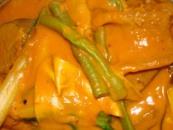Welcome to the Filipino recipes site. Featured on this site are free Filipino recipes that have become all time Philippine favorites. Traditional Filipino food recipes that are simple to cook and always a pleasure to serve and eat... dishes that are always welcome on the dining table. Filipino food consist mostly of vegetables, seafood, dairy, meat and rice. Like Philippine fiestas, Filipino recipes are rich in flavour & color.
Filipino culinary arts is greatly influenced by Chinese, European, American, Arab and Asian cuisines. A fusion of various recipes adopted from earlier traders, Asian immigrants and former colonizers.
Before the Spaniards colonized the Philippines, the country's cuisine consisted of root crops, game, vegetables and seafood. Filipino food recipes then was almost always either boiled, roasted or broiled. Foreign trade brought in all kinds of spices and plants to the Philippines. And like the Filipino today, its cuisine is a gastronomic feast from different countries and cultures - from east to west.
Filipinos have embraced as their own cuisines form other countries like the noodles from the Chinese, rice and meat dishes from the Spaniards, fast-food from the Americans and even spaghetti from the Italians. All these now form part of the Philippine cuisine - with the Filipino touch, of course.
There are however many Filipino recipes from each region of the Philippines with each region having its own unique specialty. The Ilocanos from the north are known for their Pakbet - a simple but nutritious vegetable dish. While the Bicolanos are famous for their Bicol Express a hot and spicy dish simmered in coconut milk. Overall, nothing beats the fame of the tasty pork and chicken Adobo, a dish the Philippines is known for throughout the world.
Experience the tastes and colors of Philippine food. A gastronomic delight that has been savored through many generations. Enjoy the free Filipino food recipes on this site and happy cooking!
CREDITS TO: http://www.filipinofoodrecipes.net/


